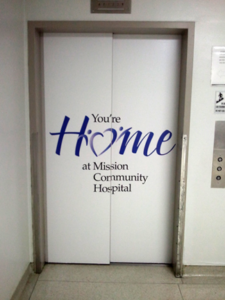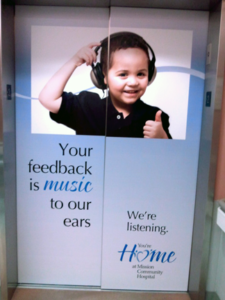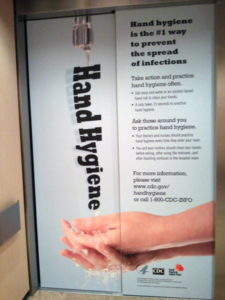Mission Hospital Elevator Decals
09 Feb
By dev1
California – Elevator wraps are being used widely in hospitals as a unique and captive communication medium for messaging to patients. Mission Hospital knew this and contacted Cranky Creative to install 16 elevators at their facility in California.
They have contracted with Cranky to change out their elevator messages on a six month campaign cycle. This way they will be able to keep their message fresh to their viewers.

Hospital Marketing Directors are always looking for ways to reach a captive audience, and they don’t come much more captive than inside elevators.
Like many forms of out-of-home advertising, the most common way to advertise in elevators is by way of traditional static signage, but there are other options. Marketers can wrap an elevator’s outside doors, or even the entire inside of an elevator.
Fast Facts
WHAT
Advertising in and on elevators.
There’s just not all that much to do on an elevator but stare at the walls.
The other key advantage of elevator advertising is the ability to target by the demographic makeup of a building’s occupants; advertisers know who they’re reaching.
The simplest and least-expensive form of elevator advertising is static ads on the interior walls of the elevator, and they’re mostly found in hospitals.

But wraps also lend themselves to colorful, truly alternative campaigns, and they can be and done anywhere, from elevator wraps, wall murals, tables, buildings, and floor decals.
Marketers can also wrap the entire inside of an elevator to put riders in a specific scene, for example a zoo ad that turns the elevator into an African safari scene.
In Los Angeles last year, an upscale women’s boutique, Kira Plastinina, wrapped the interiors of elevators in the Beverly Center shopping mall to resemble the interiors of its stores.

Effectiveness of the Media
The recall rate of elevator advertising is 96 percent, according to a study by Ryerson Polytechnical Institute in Toronto and Capilano College in Vancouver.

How it is measured
Impressions for elevator ads in apartment complexes are based on the number of tenants in a particular building and how often they use the elevator on average. Foot-traffic data is used in other locations such as malls and office buildings.
Demographics
Elevator advertisers can target a wide range of demographics based on the profiles of the individual buildings in the campaign.


